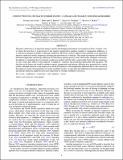| dc.contributor.author | Lecoanet, Daniel | |
| dc.contributor.author | Brown, Benjamin P. | |
| dc.contributor.author | Zweibel, Ellen G. | |
| dc.contributor.author | Oishi, Jeffrey S. | |
| dc.contributor.author | Vasil, Geoffrey M. | |
| dc.contributor.author | Burns, Keaton James | |
| dc.date.accessioned | 2015-01-22T21:27:32Z | |
| dc.date.available | 2015-01-22T21:27:32Z | |
| dc.date.issued | 2014-12 | |
| dc.date.submitted | 2014-08 | |
| dc.identifier.issn | 1538-4357 | |
| dc.identifier.issn | 0004-637X | |
| dc.identifier.uri | http://hdl.handle.net/1721.1/93161 | |
| dc.description.abstract | Thermal conduction is an important energy transfer and damping mechanism in astrophysical flows. Fourier's law, in which the heat flux is proportional to the negative temperature gradient, leading to temperature diffusion, is a well-known empirical model of thermal conduction. However, entropy diffusion has emerged as an alternative thermal conduction model, despite not ensuring the monotonicity of entropy. This paper investigates the differences between temperature and entropy diffusion for both linear internal gravity waves and weakly nonlinear convection. In addition to simulating the two thermal conduction models with the fully compressible Navier-Stokes equations, we also study their effects in the reduced "soundproof" anelastic and pseudoincompressible (PI) equations. We find that in the linear and weakly nonlinear regime, temperature and entropy diffusion give quantitatively similar results, although there are some larger errors in the PI equations with temperature diffusion due to inaccuracies in the equation of state. Extrapolating our weakly nonlinear results, we speculate that differences between temperature and entropy diffusion might become more important for strongly turbulent convection. | en_US |
| dc.description.sponsorship | Kavli Institute for Astrophysics and Space Research (Graduate Fellowship) | en_US |
| dc.description.sponsorship | National Science Foundation (U.S.). Graduate Research Fellowship Program (Grant 1122374) | en_US |
| dc.language.iso | en_US | |
| dc.publisher | IOP Publishing | en_US |
| dc.relation.isversionof | http://dx.doi.org/10.1088/0004-637X/797/2/94 | en_US |
| dc.rights | Article is made available in accordance with the publisher's policy and may be subject to US copyright law. Please refer to the publisher's site for terms of use. | en_US |
| dc.source | American Astronomical Society | en_US |
| dc.title | CONDUCTION IN LOW MACH NUMBER FLOWS. I. LINEAR AND WEAKLY NONLINEAR REGIMES | en_US |
| dc.type | Article | en_US |
| dc.identifier.citation | Lecoanet, Daniel, Benjamin P. Brown, Ellen G. Zweibel, Keaton J. Burns, Jeffrey S. Oishi, and Geoffrey M. Vasil. “CONDUCTION IN LOW MACH NUMBER FLOWS. I. LINEAR AND WEAKLY NONLINEAR REGIMES.” The Astrophysical Journal 797, no. 2 (December 3, 2014): 94. © 2014 The American Astronomical Society | en_US |
| dc.contributor.department | Massachusetts Institute of Technology. Department of Physics | en_US |
| dc.contributor.mitauthor | Burns, Keaton James | en_US |
| dc.relation.journal | Astrophysical Journal | en_US |
| dc.eprint.version | Final published version | en_US |
| dc.type.uri | http://purl.org/eprint/type/JournalArticle | en_US |
| eprint.status | http://purl.org/eprint/status/PeerReviewed | en_US |
| dspace.orderedauthors | Lecoanet, Daniel; Brown, Benjamin P.; Zweibel, Ellen G.; Burns, Keaton J.; Oishi, Jeffrey S.; Vasil, Geoffrey M. | en_US |
| dc.identifier.orcid | https://orcid.org/0000-0003-4761-4766 | |
| mit.license | PUBLISHER_POLICY | en_US |
| mit.metadata.status | Complete | |

